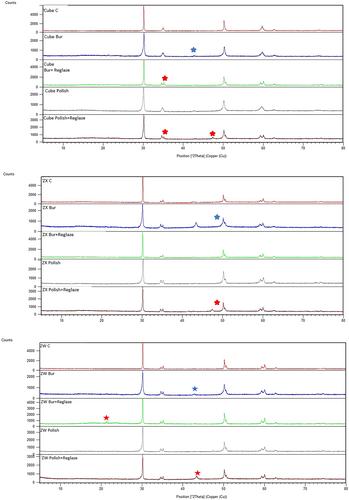Comparative effects of glazing versus polishing on mechanical, optical, and surface properties of zirconia ceramics with different translucencies
Abstract
Objectives
This study compared the effects of glazing versus polishing on mechanical, optical, and surface properties of zirconia ceramics with different translucencies.
Materials and Methods
In this in vitro study, 120 bar-shaped specimens (25 × 4 × 1.2 mm) were fabricated from three different types of zirconia with different translucencies (n = 40, DD Bio ZW, ZX2, and Cube X2). After sintering, each zirconia group was randomly divided into five subgroups of control (glazing), glazing + bur abrasion, glazing + bur abrasion + polishing with EVE Diacera® kit, glazing + bur abrasion + reglazing, and glazing + bur abrasion + polishing with EVE Diacera® kit + reglazing. The specimens underwent surface roughness, hardness, flexural strength, and translucency tests, as well as X-ray diffraction (XRD) and scanning electron microscopy (SEM) for assessment of surface topography. Data were analyzed by one-way analysis of variance, Tukey test, and Pearson test (α = .05).
Results
Flexural strength, surface hardness, and translucency were significantly correlated with zirconia type. ZW zirconia had significantly higher flexural strength and surface hardness and significantly lower translucency than Cube X2 and ZX2 (p < .001). Surface roughness had no significant correlation with zirconia type (p = .274). Polishing created the smoothest, and bur abrasion created the roughest surface (p < .001). Flexural strength and hardness in most experimental groups were significantly lower than in the control group (p < .001). Translucency was not significantly different in bur abrasion and polishing groups, compared with the control group; however, reglazing significantly increased the translucency (p < .001). SEM micrographs confirmed the surface roughness results. XRD showed monoclinic phase only in reglazed groups.
Conclusion
Of different surface treatments, polishing improved the surface properties and caused the smallest change in mechanical properties of zirconia with different translucencies.


 求助内容:
求助内容: 应助结果提醒方式:
应助结果提醒方式:


